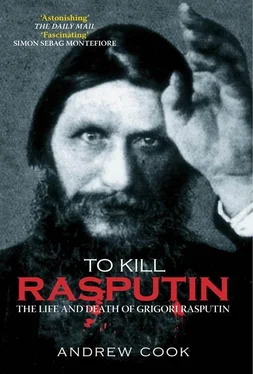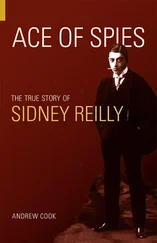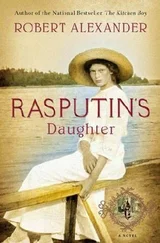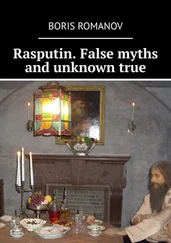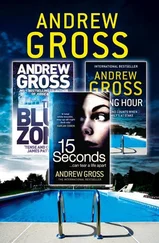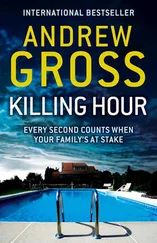There is a hiatus of at least two hours, possibly three, between the original shot or shots in the courtyard, which had brought police to the palace, and their six o’clock roll call which was interrupted by the ejection of the women. The roll call is the only reliable timing we have between the departure of Rasputin from Gorokhovaya Street and the finding of the body. At the police station, the night shift was going off duty and the much bigger day shift was coming on. There were policemen to spare, and they saw what happened: two women, drunk, were forcibly bundled out. The most likely explanation is that these women knew the men were going to commit murder and they wanted either to stop them or to participate. And the men wanted them out of the way. Another, and not a contradictory, explanation, is that they were deliberately distracting the police from a rumpus in the courtyard.
Somebody had to have the nerve to go out and drag Rasputin back in. Daylight was approaching and he had to be got away from the building and finally disposed of. Shooting was the only way to finish him off properly, but it would cause damage in a confined space like the stairwell.
An unspecified time later, four shots were heard ‘in rapid succession from the forecourt’. This does not necessarily mean that the shooting took place on the forecourt, but it is most likely. And we can treat ‘rapid succession’ with scepticism too. Had the reports alleged that the shots rang out over a five-or ten-minute period, or in the course of the women’s departure, they would have seemed incompetent. But by this stage they did not want to see anything. A diligent policeman or Okhrana agent getting mixed up with Romanovs and Princes was likely to offend the wrong person and find his career at an end.
The group of early-morning shots, fired with a brief interval between them, came from different revolvers, according to the Autopsy Report. This view is backed up by the 1993 review led by Dr Vladimir Zharov. In 2004, Zharov told BBC Timewatch that microscopic measurements of the entry wounds proved that the three bullet-holes were of different sizes. 11The report considered that the chest wound was most likely caused by a 6.35mm Browning handgun, the type used by Yusupov and Dmitri Pavlovich. The right-hand back wound was slightly larger, therefore consistent with Purishkevich’s 7.65mm Savage pistol. These two shots were, the Autopsy Report says, Fired from a distance of about 20cm, when Rasputin was standing up . 12One bullet ‘penetrated the left-hand side of his chest and passed through his stomach and liver’ and the other ‘entered the right-hand part of his back and passed through his kidneys’. Had these shots been fired simultaneously while Rasputin was sitting or standing, the assassins would have been at risk of wounding each other, diagonally through Rasputin’s body.
There must have been an interval between shots. But how would Rasputin have remained standing? It seems most likely that he was carried out with his wrists bound and propped in a sitting position against a snow-heap; two people fired at him, and one bullet hit him as he fell forwards. Both these wounds would have, in themselves, been fatal within twenty minutes.
The Autopsy Report is equally adamant that the third bullet, which was immediately fatal, was fired at point-blank range while the body was supine. The most likely scenario is that, having shot Rasputin twice, the conspirators wrapped his body in cloth and carried it across the courtyard to the waiting car. This is consistent with the scene of crime photograph taken by the police showing a straight line of blood from the doorway across the courtyard. Had Rasputin staggered across the courtyard, as claimed by Yusupov and Purishkevich, one would expect to see an irregular trail of blood. As the killers approached the gate, either a spasm or a sound from the body indicated that he was still alive, if only barely. It is at this point that the body was then put down, and someone, with a handgun of a different calibre to the ones that had fired the first and second shots, delivered the coup de grâce that ended Rasputin’s life. 13The third shot is therefore the most crucial in determining the identity of Rasputin’s killer. Professor Derrick Pounder, in his review of the ballistics evidence, observed that,
At the centre of the forehead there is a gunshot wound of entry comprising a central defect and a very prominent abraded margin with two lines of radiating accentuation at 8 o’clock and 10 o’clock which likely represent radiating lacerations. The presence of the lacerations would allow for the opening up of the central defect and the passage of a much larger bullet than might be anticipated from the size of the central defect alone. The abraded margin reflects the grazing of the stretched skin by the bullet at the moment of bullet entry. 14
Turning his attention to identifying the bullet, Professor Pounder calculated that
the central defect of the wound is about 6mm true diameter and the abraded margin between about 12 and 15mm true diameter. The overall size of the wound and prominence of the abraded margin suggests a large lead non-jacketed bullet. 15
Full metal-jacketed bullets for handguns were the norm by the outbreak of the First World War. These were completely encased in a hard metal jacket to prevent expansion upon impact. In fact, the use of expanding, unjacketed bullets in small arms ammunition had been limited and proscribed by The Hague Accords of 1899 and 1907. Britain, however, was unique in using unjacketed bullets for its standard-issue officer’s revolver, the .455-inch (11.56mm) Webley, arguing that the design was compliant with the Accords.
In considering which handgun out of the range available at the time of the murder was the one compatible with the ballistics evidence, Professor Pounder concluded that, based upon calibre,
the Webley is the likely culprit… the Webley was a revolver firing non-jacketed lead bullets while the other weapons [used by Dmitri Pavlovich, Purishkevich and Yusupov] were pistols firing jacketed ammunition, a contrast which would also favour the Webley since lead non-jacketed bullets produce the more prominent abraded margin. 16
Dr Zharov’s 1993 review supported Professor Kossorotov’s opinion that the third bullet went straight through the head, exiting from the back, although they point out that there are no photographs of the back of the head, so this cannot be established with absolute certainty. A tell-tale clue, however, is a pool of blood in the snow which is evident in the police scene of crime photograph, close to the second courtyard gate. This is consistent with an exit wound to the back of the head while the body is lying on the ground. Dr Zharov’s team also agree with Professor Kossorotov’s view that, although Rasputin’s body was removed from the courtyard and thrown in the river, he was already dead and did not, therefore, drown.
The cause of death was not drowning… the lungs were not swollen and there was no water in the respiratory organs. 17
Although the lungs contained a small amount of water, Professor Derrick Pounder also agreed that,
since the diagnosis of drowning is one of exclusion based upon all of the evidence it is clear that he did not drown, given the presence of a prior lethal injury. The fluid on the lungs is a common non-specific autopsy finding which is not a diagnosis of drowning. 18
The above reconstruction of events is based upon a best-fit scenario taking into account the timings, reports and statements made in contemporary documents.
Whether the shots were indeed fired inside the building or outside in the courtyard, at whatever time of the night, it is clear beyond doubt from the forensic evidence that the following is true:
Читать дальше
